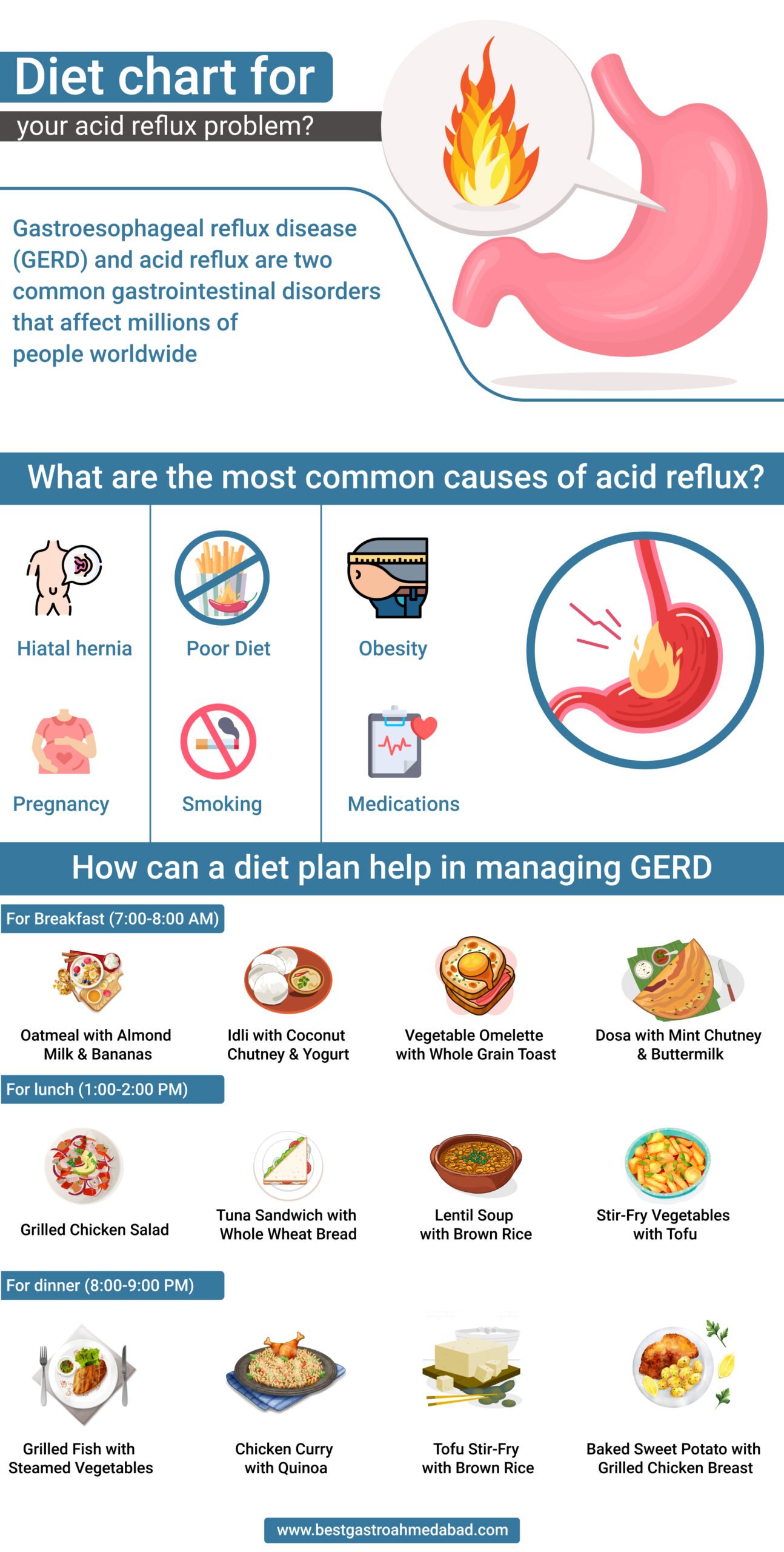How important is a diet chart for your acid reflux problem?

Gastroesophageal reflux disease (GERD) and acid reflux are two common gastrointestinal disorders that affect millions of people worldwide. Both conditions are characterized by a backflow of stomach acid into the esophagus, causing a burning sensation in the chest or throat, also known as heartburn. Other typical symptoms include regurgitation, bloating, belching, and difficulty swallowing. While occasional acid reflux is normal, frequent and persistent symptoms can indicate GERD, which can lead to serious complications if left untreated, such as esophagitis, Barrett’s esophagus, and even esophageal cancer. Therefore, it is crucial to manage this condition with a proper diet plan, including an acid reflux diet, diet chart for acid reflux, or diet chart for GERD, to alleviate symptoms and prevent further damage to the esophagus.
What are the most common causes of acid reflux?
- Hiatal hernia: A condition where the upper part of the stomach protrudes through the diaphragm into the chest, allowing stomach acid to flow back into the esophagus.
- Poor diet: Consuming foods high in fat, spicy, acidic or fried foods, caffeine, alcohol, and carbonated drinks can trigger acid reflux symptoms. Following an acid reflux diet, diet chart for acid reflux, or diet chart for GERD can help reduce these symptoms.
- Obesity: Excess weight can put pressure on the stomach, causing acid to flow back into the esophagus.
- Pregnancy: Hormonal changes and increased pressure on the abdomen during pregnancy can lead to acid reflux.
- Smoking: Nicotine weakens the lower esophageal sphincter, allowing stomach acid to flow back into the esophagus.
- Medications: Certain medications such as painkillers, antibiotics, and blood pressure drugs can relax the lower esophageal sphincter and increase the risk of acid reflux.
- Underlying medical conditions: Acid reflux can be a symptom of underlying conditions such as gastroesophageal reflux disease (GERD), peptic ulcers, and gastroparesis.
How can a diet plan help in managing GERD?
Following a diet plan is crucial for managing acid reflux because certain foods and beverages can trigger symptoms by relaxing the lower esophageal sphincter, increasing stomach acid production, or irritating the lining of the esophagus. For example, high-fat foods and spicy foods can delay stomach emptying, leading to acid reflux. Acidic foods, such as citrus fruits and tomatoes, can also irritate the esophagus. Alcohol, caffeine, and carbonated beverages can also worsen symptoms by increasing stomach acid production. On the other hand, a diet high in fiber, fruits, and vegetables can help regulate digestion and reduce the risk of acid reflux. Following an acid reflux diet, diet chart for acid reflux, or diet chart for GERD can help individuals identify trigger foods and make healthier choices that can alleviate symptoms and improve overall digestive health.
What is a perfect Indian diet plan for managing Acid reflux?
For Breakfast (7:00-8:00 AM)
| Oatmeal with Almond Milk and Bananas
|
|
| Idli with Coconut Chutney and Yogurt |
|
| Vegetable Omelets with Whole Grain Toast |
|
| Dosa with Mint Chutney and Buttermilk |
|
| Upma with Green Tea |
|
For mid morning snack (10:00-11:00 AM)
| Apple Slices with Almond Butter |
|
| Carrot Sticks with Hummus |
|
| Yogurt with Berries |
|
| Roasted Chickpeas with Cumin |
|
| Rice Cake with Avocado |
|
For lunch (1:00-2:00 PM)
| Grilled Chicken Salad |
|
| Tuna Sandwich with Whole Wheat Bread |
|
| Lentil Soup with Brown Rice |
|
| Stir-Fry Vegetables with Tofu |
|
| Baked Salmon with Sweet Potato |
|
For afternoon snack (4:00-5:00 PM)
| Banana with Almond Butter |
|
| Greek Yogurt with Berries |
|
| Whole Grain Crackers with Hummus |
|
| Roasted Chickpeas with Spices |
|
| Carrot Sticks with Guacamole |
|
For dinner (8:00-9:00 PM)
| Grilled Fish with Steamed Vegetables |
|
| Tofu Stir-Fry with Brown Rice |
|
| Chicken Curry with Quinoa |
|
| Lentil Soup with Salad |
|
| Baked Sweet Potato with Grilled Chicken Breast |
|
What food items can worsen the symptoms of acid reflux?
- Spices: Spices like chili powder, cumin, and turmeric can trigger acid reflux and should be used in moderation or avoided altogether.
- Fried Foods: Fried foods like samosas, pakoras, and bhajias are high in fat and can cause acid reflux.
- Citrus Fruits: Citrus fruits like lemon, lime, and oranges are highly acidic and can aggravate acid reflux.
- Tomato-Based Foods: Tomato-based foods like tomato soup, tomato sauce, and ketchup are highly acidic and can trigger acid reflux.
- Carbonated Drinks: Carbonated drinks like soda and fizzy drinks can increase stomach acid production and cause acid reflux.
- Coffee and Tea: Coffee and tea can also increase stomach acid production and should be consumed in moderation.
- Dairy Products: High-fat dairy products like whole milk, cheese, and cream can cause acid reflux.
Conclusion
In conclusion, the right diet can play a crucial role in managing acid reflux and GERD. It is important to follow a diet chart for acid reflux that includes foods that are low in fat, low in acid, and easy to digest. Patients should avoid trigger foods that can aggravate their symptoms and eat small, frequent meals throughout the day. It is also important to stay hydrated by drinking plenty of water and avoiding carbonated drinks. However, each person’s triggers and tolerance for certain foods are different. Therefore, it is crucial to consult a doctor to get a personalized diet plan based on individual needs and symptoms. Dr. Vatsal Mehta is an experienced professional who can guide patients through the process of creating an effective diet plan to manage their acid reflux and GERD symptoms. To fix an appointment with our specialists at Alfa Liver and Gastro care

